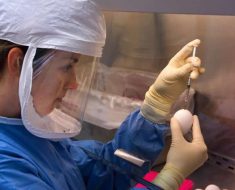
Hair loss and the development of skin wrinkles are something we all begin to experience, to greater or lesser degree, as we grow older.
These symptoms of aging are largely dictated by decline of mitochondrial function within cells.
Mitochondria are key cellular structures that produce adenosine triphosphate (ATP), the “fuel” that maintains healthy cellular function.
When mitochondria can no longer function properly or produce the required amount of ATP, this can have harmful consequences.
Other than leading to the wrinkling of skin and hair loss, mitochondrial dysfunction can contribute to the development of many chronic diseases.
In a recent study, Keshav Singh — from the University of Alabama at Birmingham — and colleagues have been experimenting with ways of reversing a DNA mutation that leads to mitochondrial dysfunctions.
In a paper now published in the journal Cell Death & Disease, the researchers report that in working with a mouse model, they have been successful in restoring mitochondrial function, thereby reversing the wrinkles and hair loss observed in the rodents.
“To our knowledge, this observation is unprecedented,” says Singh.

The mutation that triggers signs of aging
Singh and colleagues explain that changes in mitochondrial function occur due to a mutation that happens in a nuclear gene — a type of gene found in the nucleus of cells — which leads to a depletion of mitochondrial DNA.
To induce this mutation in the mouse model, the researchers used doxycycline, an antibiotic that they added to the rodents’ food or water. The mice that received this treatment began to show signs consistent with those observed in aging within only 4 weeks from its commencement.

Soon, their hair turned gray, they experienced hair loss, and they became more lethargic. Within 4–8 weeks of the treatment, the animals also began to present wrinkled skin, and this affected the females more severely than it did the males.
The wrinkled skin showed the kind of changes that are observed due to both intrinsic aging and extrinsic (external) stress that produces skin damage. Changes consistent with extrinsic aging included too many skin cells, thickening of the outmost layer of the skin, unhealthy hair follicles, and increased inflammation.
Singh and team also noted that the mice had an altered expression of matrix metalloproteinases, which are enzymes that help support the collagen fibers that prevent the wrinkling of skin tissue.

A reversible factor?
However, the researchers observed few shifts in the tissue of other organs after having induced the genetic mutation. This, they believe, suggests that mitochondria play a more important role in the health of skin tissue versus other kinds of tissue.
Fortunately, the scientists found that they were able to reverse these changes in the mice by switching off the genetic mutation they had at first induced.
Within a month after stopping the doxycycline treatment, the mitochondrial DNA was beginning to replenish, and the mice regained their hair — in its initial color — and their wrinkles were smoothened out.
This, Singh says, suggests that mitochondrial function may be a reversible factor tied to the aging of skin and hair — which, he adds, is a “surprising” finding.
“It suggests that epigenetic mechanisms underlying mitochondria-to-nucleus cross-talk must play an important role in the restoration of normal skin and hair phenotype,” explains Singh.
“This mouse model should provide an unprecedented opportunity for the development of preventive and therapeutic drug development strategies to augment the mitochondrial functions for the treatment of aging-associated skin and hair pathology and other human diseases in which mitochondrial dysfunction plays a significant role.”
Keshav Singh
The researchers hope that further studies will be help them clarify whether similar procedures could, in the future, be used to reverse symptoms of aging in other types of tissue, as well.
Source: Read Full Article





